There are millions of animals around the world with all kinds of different shapes and sizes — from mighty elephants to tiny insects. However, some of these animals have particularly large heads! Let’s take a look at the full list of animals with big heads. We bet there’s a few that’ll surprise you!
1. African Bush Elephant

African bush
elephants
are the largest elephant species; they are also an endangered animal.
©Volodymyr Burdiak/Shutterstock.com
The magnificent African bush elephant is the largest land animal in the world. African bush elephants are the largest elephant species; they are also an endangered animal. They are native to sub-Saharan Africa where they inhabit grasslands, forests, wetlands, and even agricultural land. Adult bull elephants can stand as high as 13 feet at the shoulder and can typically weigh up to around 14,000 pounds. In addition to their massive head, they also have huge ears, which can be more than 6 feet long and 4 feet wide, and tusks which can be up to 8 feet long.
2. Angler Fish

Their teeth are angled inwards to make it easier for them to grab their prey and pull them into their mouth.
©iStock.com/plovets
Angler fish are an order of bony fish (Lophiiformes) which are characterized by large heads and huge mouths with rows of fearsome-looking teeth. Their teeth are angled inwards to make it easier for them to grab their prey and pull them into their mouth. Their diet consists of a wide variety of crustaceans, fish, squid, turtles, and even some sea birds. Surprisingly, most anglerfish are fairly small, although the largest species can be up to 3ft 3ins.
3. American Bison

These huge animals are characterized by a dark brown coat and a large head with short, curved horns.
©iStock.com/Jillian Cooper
No list of animals with big heads would be complete without the mighty American bison, the largest land mammal in North America. American bison can reach a massive 6ft 7ins at the shoulder and weigh up to 2,500 pounds. These huge animals are characterized by a dark brown coat and a large head with short, curved horns. They have a broad forehead, and their heads are typically 25 to 30 inches from the top of their horns to the bottom of their chin. Bison are herbivores and once roamed the U.S. in great herds before they were hunted almost to extinction during the 19th century. However, they have since been reintroduced to many states.
4. Basking Shark

These sharks have gill rakers, which are cartilaginous projections used to prevent prey from being pushed back out over the gills with the water.
©Martin Prochazkacz/Shutterstock.com
The second largest shark in the world is the basking shark, which is one of only three filter-feeding sharks. Basking sharks average 23 to 28 feet long and have a massive mouth up to 3 feet wide. Basking sharks prey predominantly on zooplankton which they catch by swimming forward with their mouth open. They possess gill rakers, which are typically cartilaginous projections that are used to prevent their prey from being pushed back out over the gills with the water as they feed.
5. Baboon
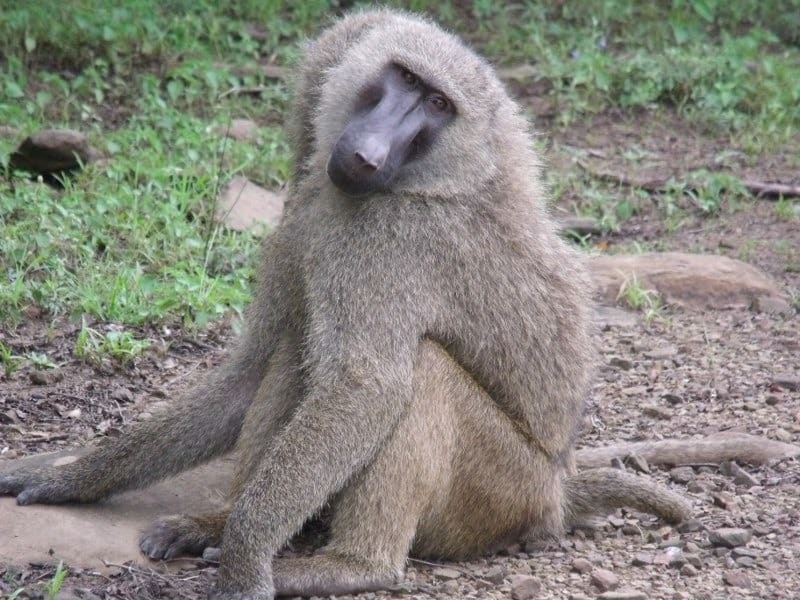
Baboons have long muzzles with a powerful jaw and long canine teeth.
©Florence Bond – Copyright A-Z Animals
There are six living species of baboons in the world, and they are distributed across Southwest Arabia and sub-Saharan Africa. They are ground dwelling animals and prefer to live in open woodlands and savannahs. Baboons are amongst the largest living primates. The biggest species — the cape baboon — is 47 inches long and can weigh up to 88 pounds. Baboons have long muzzles with a powerful jaw and long canine teeth. All baboons exhibit sexual dimorphism and males are larger than females. Baboons are omnivores and have a varied diet which includes grass, fruit, leaves, insects, rodents, birds, and vervet monkeys.
6. Beluga Whale
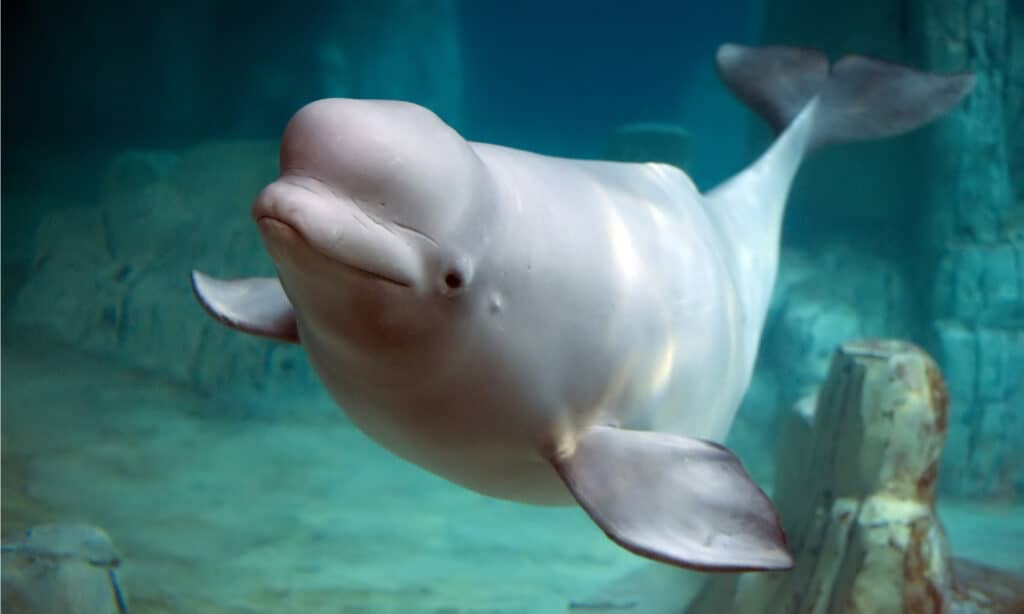
Beluga whales also have a noticeably bulbous forehead, which contains the melon (an organ that is made up of fatty tissue).
©Luna Vandoorne/Shutterstock.com
Also known as the white whale, the beluga whale is a distinctive white color, although calves are born grey and lighten as they age. Beluga whales are one of the smallest species of whale and attain lengths of between 10 and 18 feet. However, they have a stocky body which lacks a dorsal fin. They are perfectly adapted to living in the sub-zero Arctic waters. Beluga whales also have a noticeably bulbous forehead, which contains the melon (an organ that is made up of fatty tissue). The melon is used for echolocation and communication.
7. Blue Whale

The krill are caught on the huge baleen plates in their mouth as they filter the water back out before swallowing.
©Andrew Sutton/Shutterstock.com
Next up is the blue whale, which is the largest animal alive today. It has the largest animal head in the world! Blue whales are a mighty 100 feet long and their skull alone can be 16 to 18 feet! Blue whales are baleen whales, and, like the basking shark, they are filter feeders. They prey predominantly on krill which they catch by swimming towards them with their mouths open. The krill are caught on the huge baleen plates in their mouth as they filter the water back out before swallowing.
8. Bowhead Whale
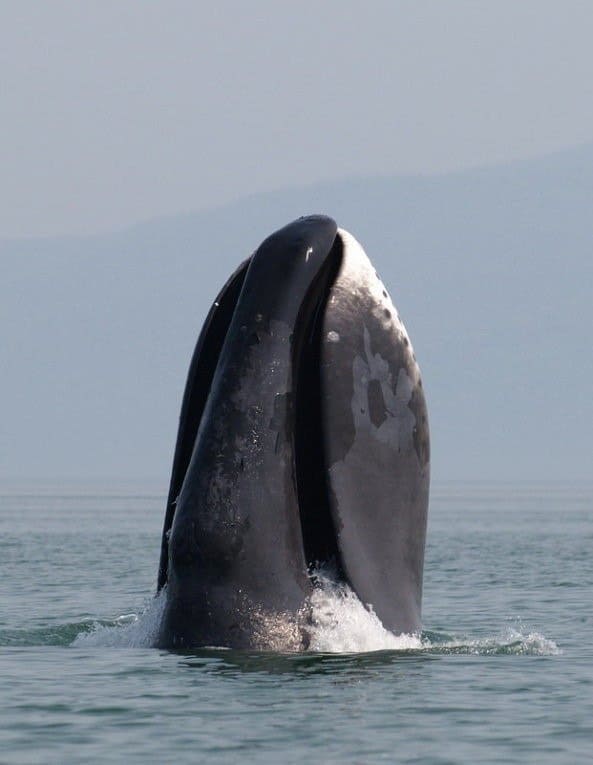
Bowhead whales have an incredibly long lifespan. Scientists believe they can live for up to 200 years.
©Olga Shpak / CC BY-SA 3.0, via Wikimedia Commons – License
The bowhead whale is another baleen whale. It reaches lengths of around 62 feet. They live in the cold Arctic waters in the Northern Hemisphere and have the thickest blubber of any whale to help protect them from the cold. They also have a massive head which helps them to break through ice of up to 2 feet thick. Bowhead whales have a triangular-shaped skull which is around one third of their body length, or around 20 feet long. Bowhead whales also have an incredibly long lifespan and scientists believe they can live for up to 200 years. This is based on the stone harpoon tips that have been found in some whales.
9. Drill

Drills have large bodies with short tails but big heads with an elongated muzzle and pronounced canine teeth.
©Jens Otte/Shutterstock.com
The drill is an endangered Old-World monkey which is closely related to the mandrill. They exhibit sexual dimorphism, and the males are much larger, weighing up to 44 pounds compared to only 28 pounds for females. Drills have large bodies with short tails but big heads with an elongated muzzle and pronounced canine teeth. They inhabit lowland forests in Western Africa in groups that consist of 20 to 30 individuals. They forage on the ground but typically climb into trees to sleep.
10. Gaboon Viper
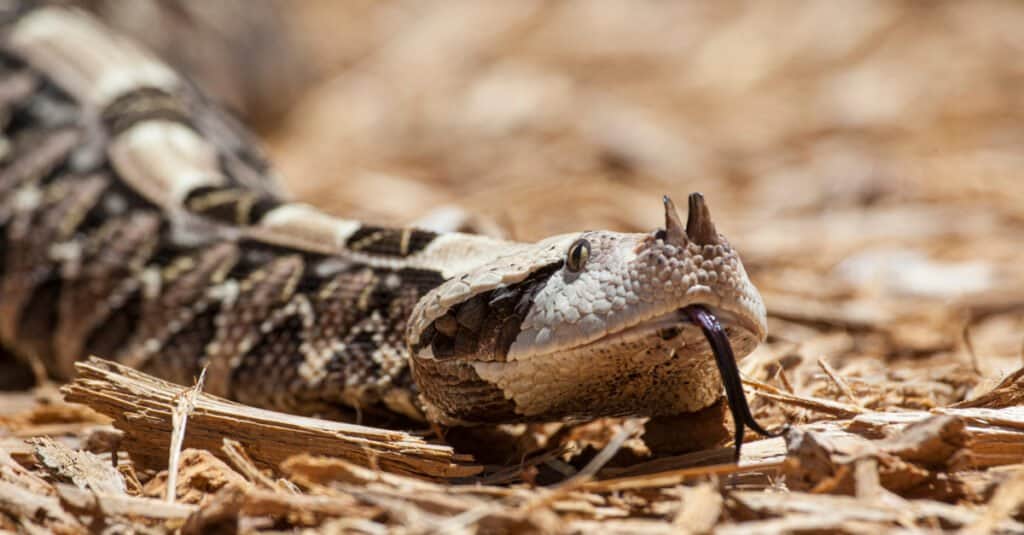
Gaboon vipers have the highest venom yield and the longest fangs of any venomous snake.
©Danita Delimont/Shutterstock.com
Also sometimes called the gaboon adder, the gaboon viper (Bitis gabonica) is a highly venomous snake that is native to sub-Saharan Africa. Gaboon vipers have the highest venom yield and the longest fangs of any venomous snake. Their fangs are up to 2 inches long and they possess cytotoxic venom. Gaboon vipers are typically 4-5 feet long and have brown bodies with a series of blotches and hourglass markings down their back as well as light-colored stripes on their flanks. Gaboon vipers have a large, triangular-shaped head which can be up to 7 inches at its widest point. They also have two pointed rostral horns between their nostrils.
11. Giant Pacific Octopus

The giant Pacific octopus is distributed across the Pacific Ocean, where they’re typically found in shallow coastal waters.
©karen crewe/Shutterstock.com
The largest species of octopus in the world is the giant Pacific octopus (Enteroctopus dofleini), which has an average arm span of 14 feet. They also have a large, bulbous head with a powerful beak that they use to kill their prey. Giant Pacific octopuses prey on a wide range of shrimp, crabs, fish, squid, lobsters, and other octopuses which they catch with their long arms. The giant Pacific octopus is distributed across the Pacific Ocean, where they’re typically found in shallow coastal waters, although they can occur at depths up to 4,920 feet.
12. Gorilla
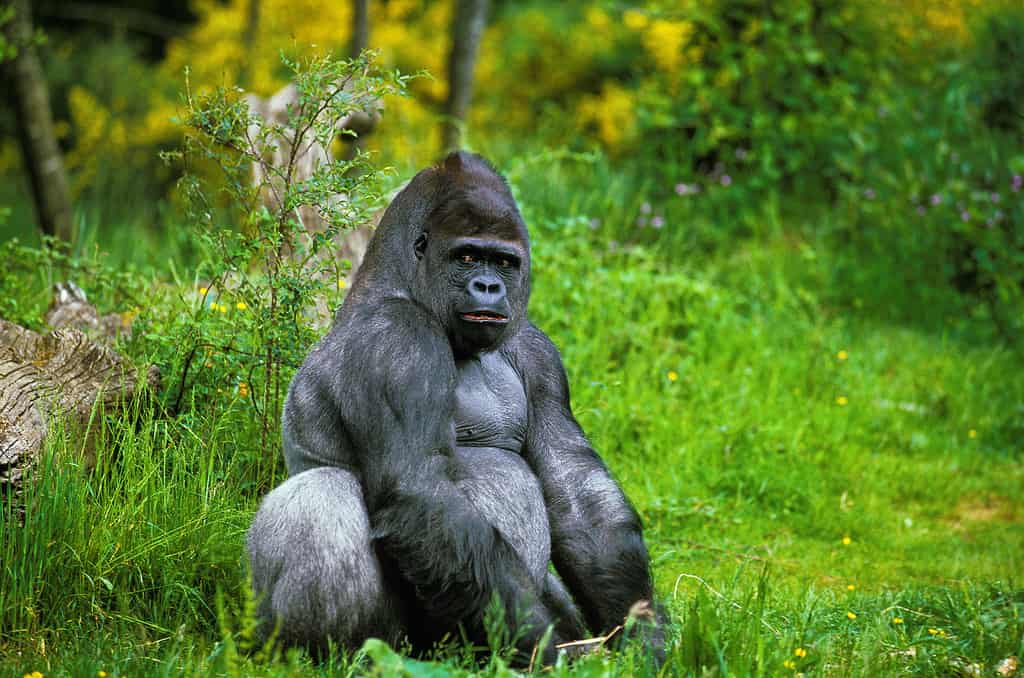
These remarkable animals are the largest living primates. Adult males — also known as silverbacks — can weigh up to 500 pounds!
©slowmotiongli/Shutterstock.com
Gorillas live in tropical and sub-tropical forests across sub-Saharan Africa. These remarkable animals are the largest living primates. Adult males — also known as silverbacks — can weigh up to 500 pounds! The males also have large heads. They have a distinctive conical shape due to the bony bump on the top and back of the skull. This crest supports the muscles that the gorilla needs to open his jaw and grind his teeth through coarse plant material. Female gorillas also have this crest, but it is not as big or as noticeable as the males’.
13. Great Hammerhead Shark
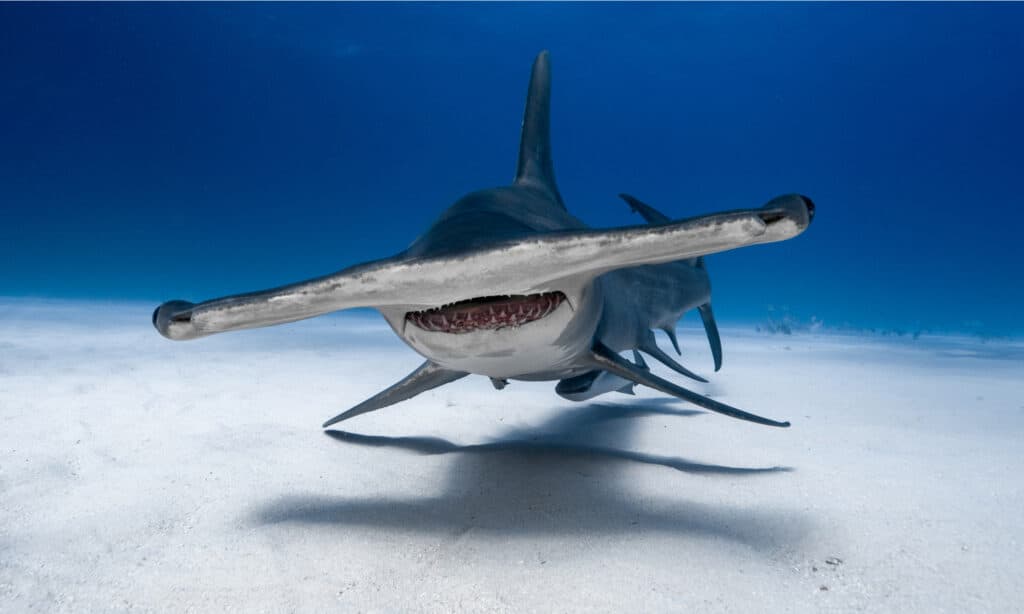
Great hammerheads are the largest species of
hammerhead shark
and have a distinctive hammer-shaped head with a straight leading edge.
©Sail Far Dive Deep/Shutterstock.com
When it comes to animals with big heads, we’ve got to mention the great hammerhead shark. Great hammerheads are the largest species of hammerhead shark and have a distinctive hammer-shaped head with a straight leading edge that sets them apart from other hammerhead species. These sharks are typically around 15 feet long and the width of their “hammer” is usually 25% to 27% of the length of their body. Great hammerheads are critically endangered as they are heavily fished around the world for their fins.
14. Green Humphead Parrotfish

These odd-looking parrotfish are around 5 feet long and have a prominent, bulbous forehead.
©SeraphP/Shutterstock.com
One of the most unusual animals on our list is the green humphead parrotfish (Bolbometopon muricatum), which is the largest species of parrotfish. These parrotfish are around 5 feet long and have a prominent, bulbous forehead. They also have exposed teeth plates as their lips do not fully cover them. Green humphead parrotfish are herbivores and their powerful beaks are useful for pulling and scraping at the plants and coral on the reefs where they feed.
15. Hammer-Headed Bat
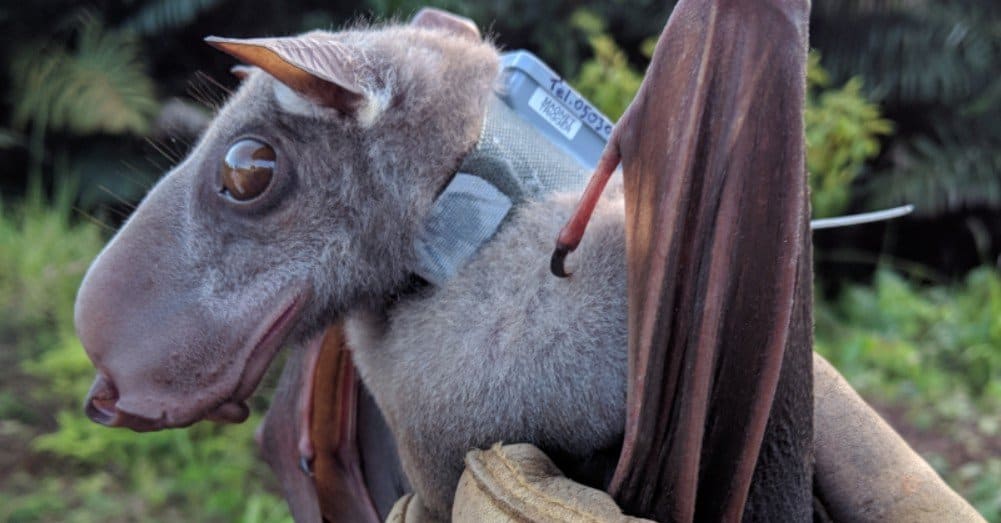
Males have a massive wingspan of almost 3 feet. They also have an enlarged larynx, a square-shaped head, and enlarged lips.
©Sarah H. Olson, Gerard Bounga, Alain Ondzie, Trent Bushmaker, Stephanie N. Seifert, Eeva Kuisma, Dylan W. Taylor, Vincent J. Munster, Chris Walzer / CC0 1.0 – License
One of the most unusual bats is the hammer-headed bat (Hypsignathus monstrosus), a fruit bat that is native to Western and Central Africa. Hammer-headed bats exhibit sexual dimorphism, with males being much larger than females. Males can weigh up to twice as much as females and have a massive wingspan of almost 3 feet. They also have an enlarged larynx, a square-shaped head, and enlarged lips. As a result, these bats have a pronounced snout and a skull that is larger than other bats in Africa. Hammer-headed bats are frugivores and can travel up to 6 miles in search of food.
16. Hippopotamus

They have an elongated skull and a broad, flat forehead which often makes their head appear heavy.
©iStock.com/curioustiger
Hippos are easily recognized by their barrel-shaped bodies, stocky legs, and large head. They have an elongated skull and a broad, flat forehead which often makes their head appear heavy. Hippos are some of the most dangerous animals in Africa owing to their powerful jaws, long teeth, massive bite force, and aggressive nature. In fact, hippos can open their jaws to an incredible 4 feet wide!
17. Horse
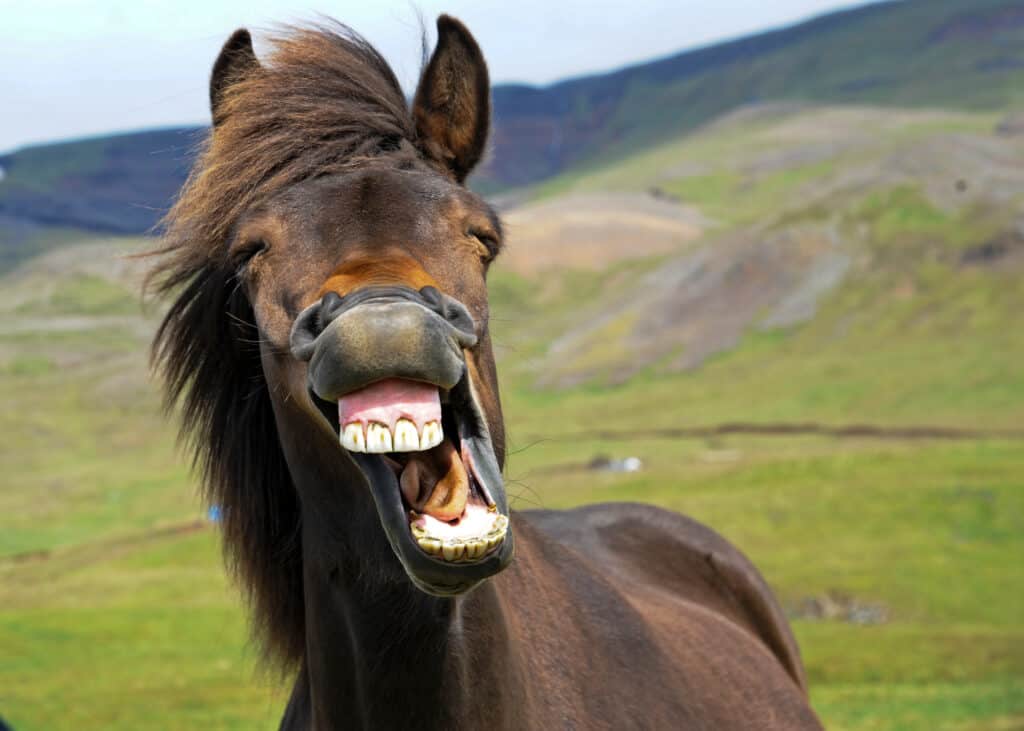
The position of their eyes so far above their mouth allows them to scan the surrounding area for any potential threat while they are eating.
©Alyson W. Kast/Shutterstock.com
Why the long face? Although sometimes the butt of jokes, horses really do have long faces! However, the shape and size of their head actually means that they are perfectly adapted to their lifestyle. Horses are grazing animals. The position of their eyes so far above their mouth allows them to scan the surrounding area for any potential threat while they are eating. Plus, the position of their ears also helps them listen for threats. Because horses are flight animals, the earlier they can detect any danger, the better their chance of getting away.
18. Humphead Wrasse
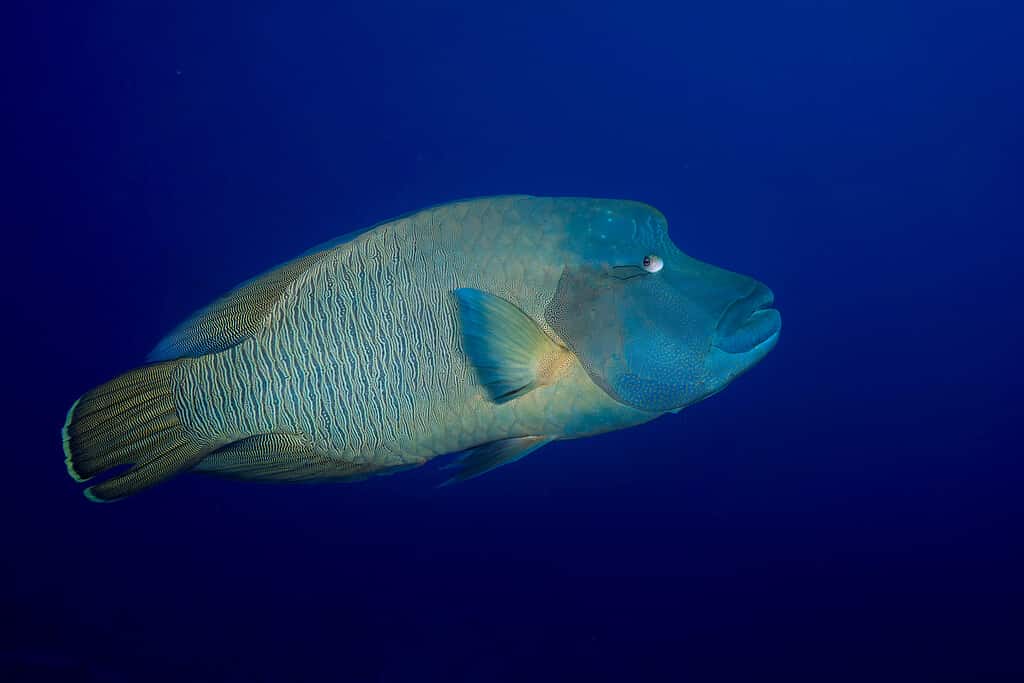
Humphead wrasses are typically blue or greenish-colored and can reach more than 6 feet in length.
©imageBROKER.com/Shutterstock.com
Much like the parrotfish, the humphead wrasse (Cheilinus undulatus) has a large, bulbous forehead. They also have thick lips on a protruding mouth. Humphead wrasses are typically blue or greenish-colored and can reach more than 6 feet in length. They are an endangered species and live along the east coast of Africa, as well as in some parts of the Indo-Pacific oceans.
19. Lion
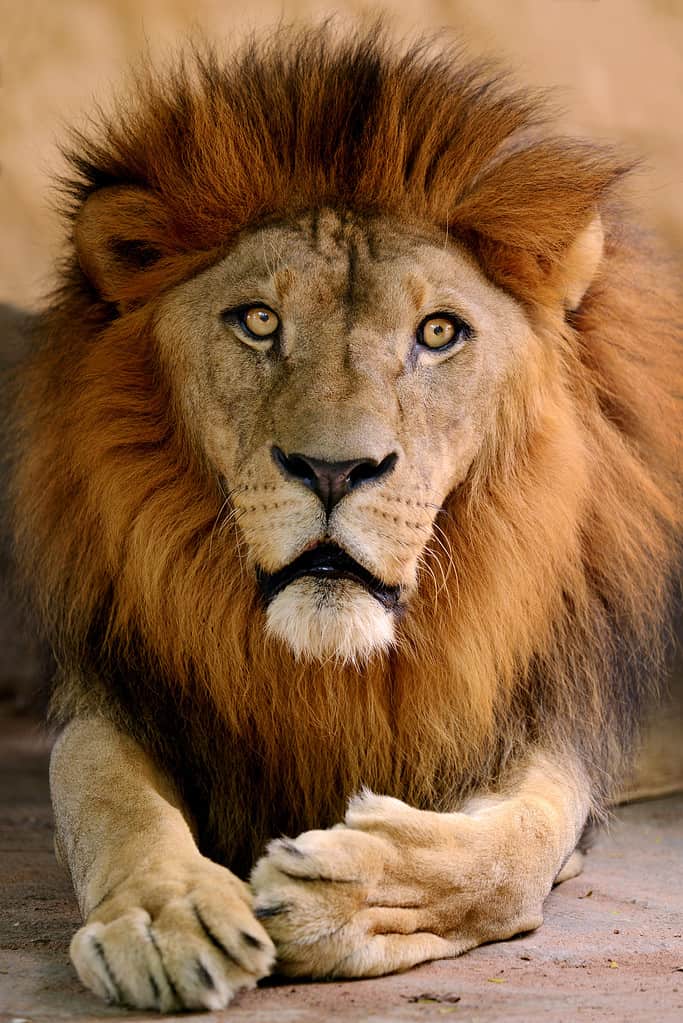
Famed for their magnificent mane, male lions have a broad head, powerful jaws, and a muscular chest and shoulders.
©dangdumrong/Shutterstock.com
Is there anything more impressive than the king of the jungle? Lions are sexually dimorphic, and males are larger than females. Famed for their magnificent mane, male lions have a broad head, powerful jaws, and a muscular chest and shoulders. The largest males can reach around 500 pounds and have a head and body length of almost 7 feet. Lions are apex predators and typically prey on a wide range of ungulates – including wildebeest, zebra, and buffalo.
20. Mandrill
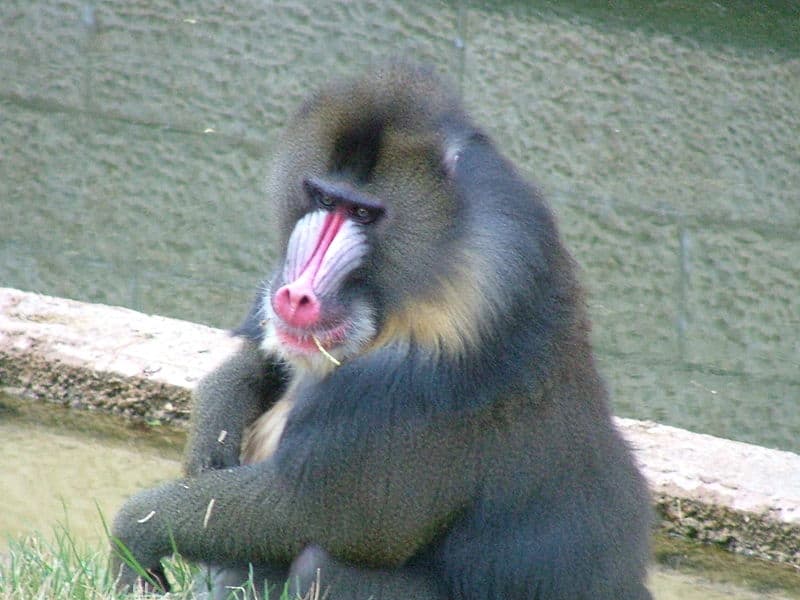
Madrills have a large head with an elongated muzzle and long canine teeth. They are some of the most colorful animals in the world.
Like the drill, the mandrill is an Old-World monkey. It inhabits the western to central region of Africa. Madrills have a large head with an elongated muzzle and long canine teeth. They are some of the most colorful animals in the world and have bright blue and red markings on their faces. Mandrills live in large family groups called hordes in rainforests and montane forests at elevations up to 6,500 feet.
21. Midas Cichlid
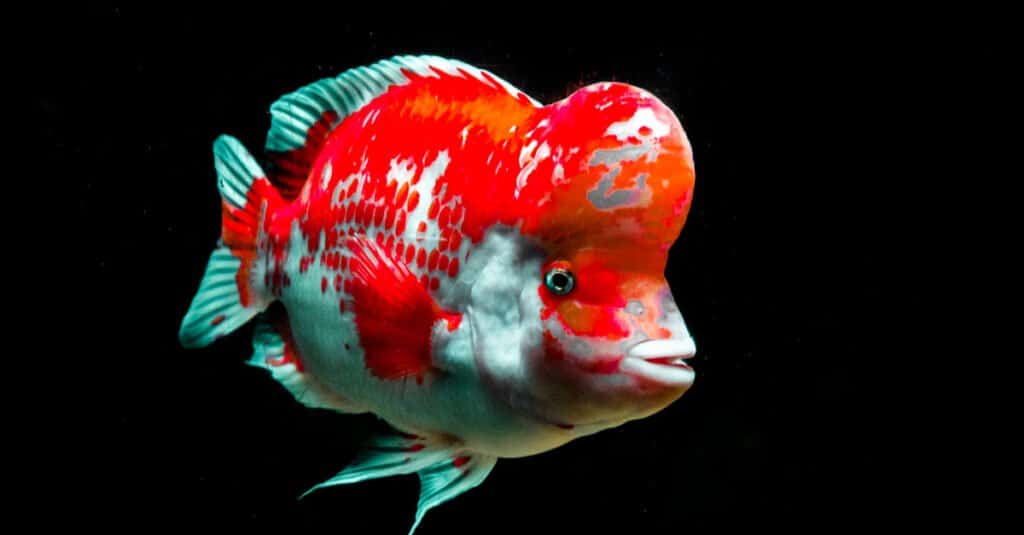
Midas cichlids reach approximately 1 foot long and males have a larger forehead hump than females do.
©Andrej Jakubik/Shutterstock.com
Another animal with a pronounced forehead is the midas cichlid (Amphilophus citrinellus) which is a popular aquarium species. Midas cichlids reach approximately 1 foot long and males have a larger forehead hump than females do. They are omnivores and eat a range of plant materials and smaller fish. Midas cichlids are powerful fish and have strong jaws with sharp teeth. They can be quite aggressive towards other species, so aquarium mates should be chosen carefully when you have midas cichlids.
22. Musk Ox
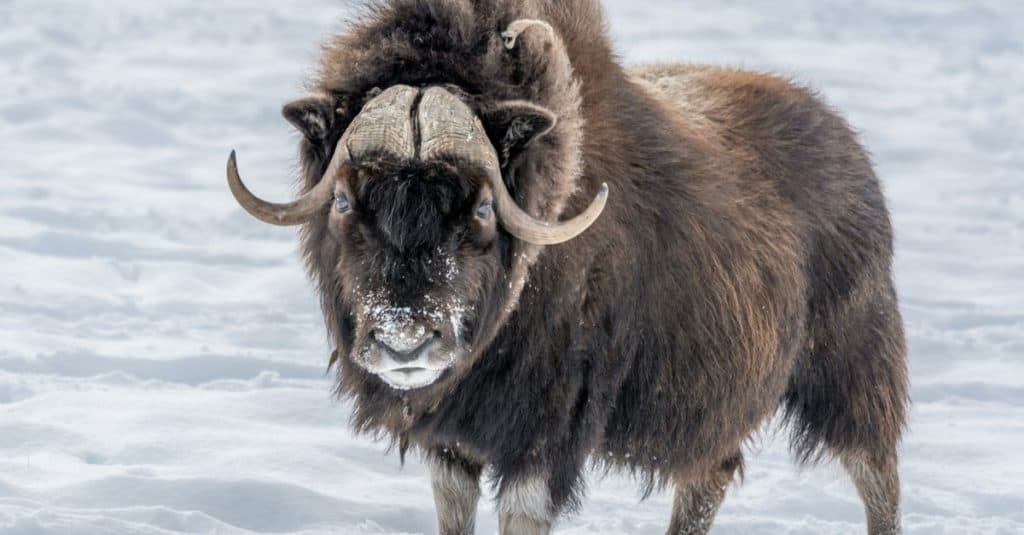
During the rutting season, males will often fight by butting heads and locking horns in huge clashes.
©Fitawoman/Shutterstock.com
One of the most imposing looking animals on our list is the musk ox, which has a stocky body and a large head with a set of long, curved horns. Although they only stand around 5 feet high at the shoulder, musk ox can weigh between 500 and 900 pounds. During the rutting season, males will often fight by butting heads and locking horns in huge clashes. However, one of the most fascinating things about these impressive animals is the way that they protect their young. When there is a threat, the entire herd will stand in an outward-facing ring around the calves. Musk ox can be found in Alaska, Canada, Greenland, and parts of Europe.
23. Moose
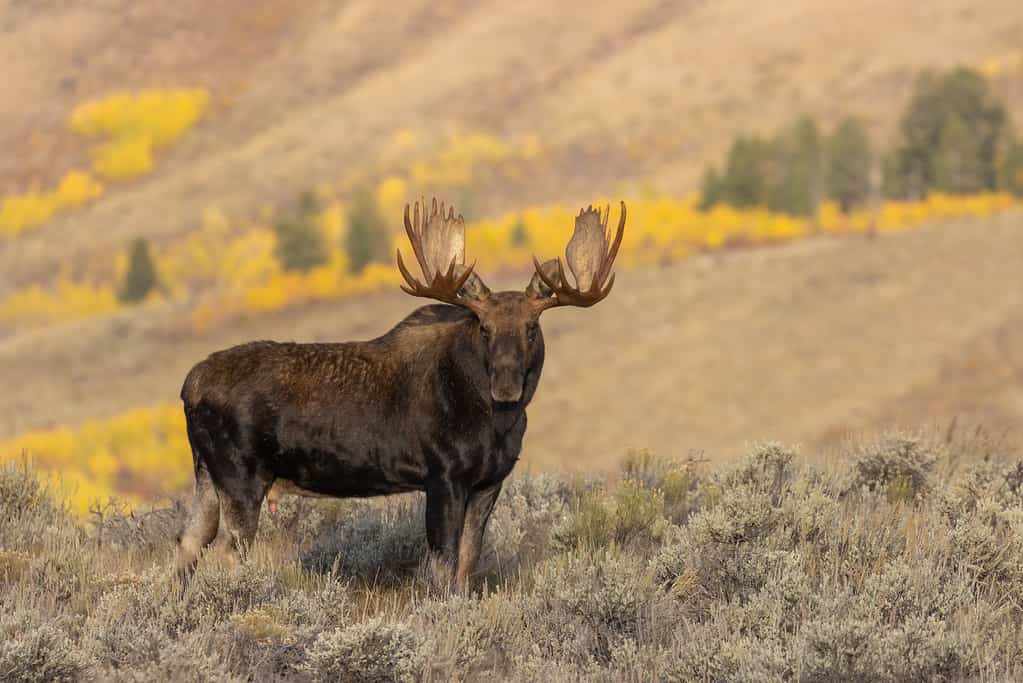
Moose have a large flap of skin underneath their chin called a dewlap. They also have a broad muzzle and fatty pads across their nostrils.
©Tom Tietz/Shutterstock.com
Up next is an animal with a long face and a mighty set of horns — moose! Moose are the largest species of deer in the world and can reach almost 7 feet at the shoulder. Moose have a large flap of skin underneath their chin called a dewlap. They also have a broad muzzle and fatty pads across their nostrils. They are able to use these pads to close their nostrils, allowing them to graze on aquatic vegetation while their heads are submerged in water. Moose are excellent swimmers and can even dive up to 20 feet under the water.
24. Orangutan
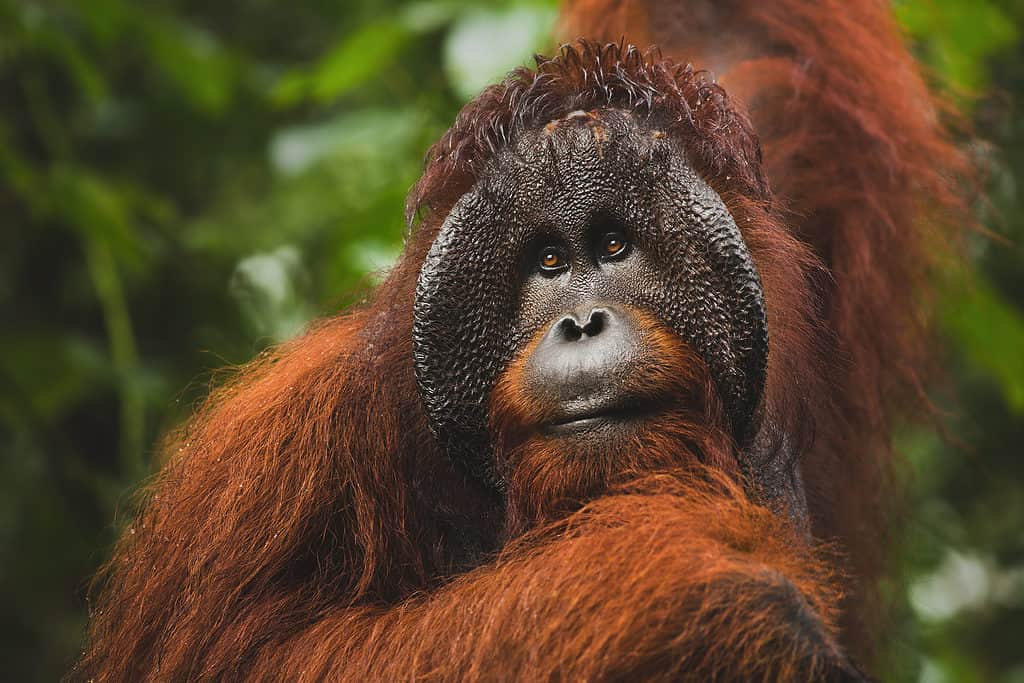
They have cheek pads which frame the sides of their faces and make them look quite large. These pads channel the sounds that they make.
©Marketa Myskova/Shutterstock.com
You might be surprised to see orangutans on this list, but male orangutans have significantly larger heads than females. This is because they have cheek pads which frame the sides of their faces and make them look quite large. These pads are believed to channel the sounds that they make in a way similar to that of a megaphone. They also make the orangutan appear bigger and more of a threat to other males.
25. Owl
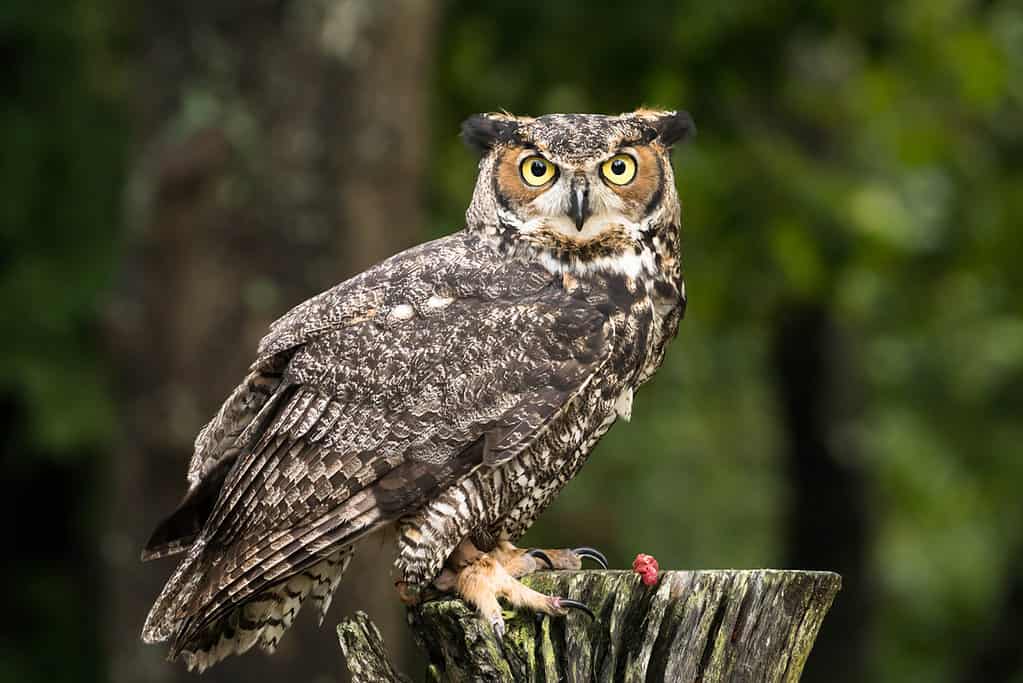
Incredibly, the flat shape of their face and the ring of feathers around their eyes helps them to hear better by focusing sounds on their ears.
©iStock.com/makasana
Owls are another animal that you may be surprised to see on this list. However, they have large heads with round, flat faces and forward-facing eyes. Incredibly, the flat shape of their face and the ring of feathers around their eyes helps them to hear better by focusing sounds on their ears.
26. Rhinoceros
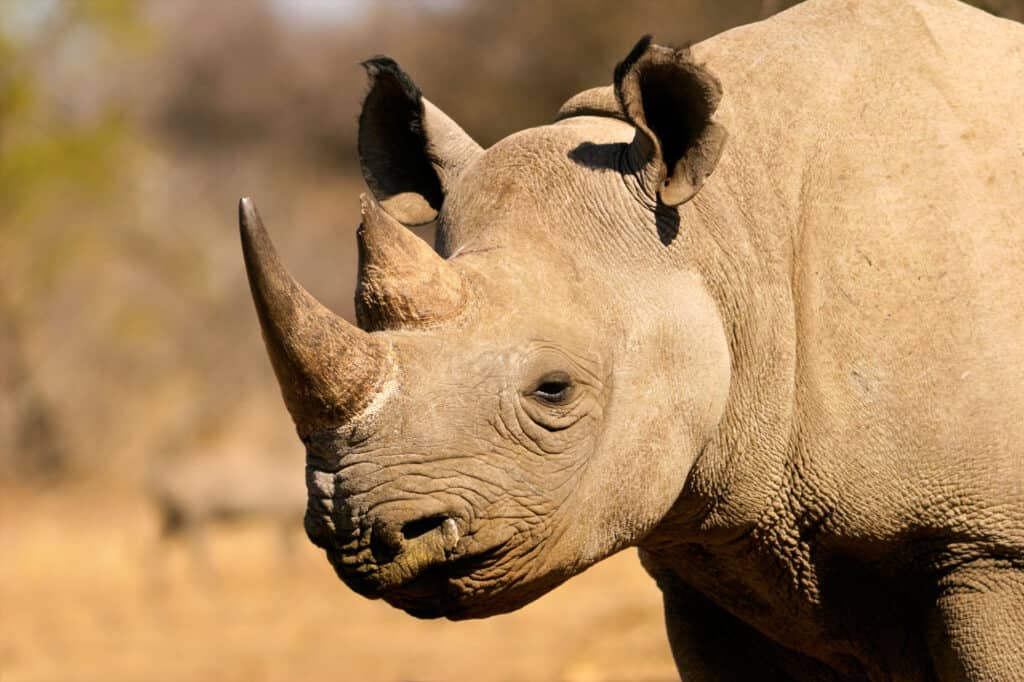
Due to their large size and temperamental nature, rhinos have no natural predators, although they are frequently hunted by poachers.
©iStock.com/EcoPic
The mighty rhinoceros is easily one of the most distinctive animals in the world. There are five living species of rhinos, and they have massive heads with one or two horns. The white rhino is the largest species. They average 6 feet high at the shoulder and weigh as much as 5,000 pounds! Their head alone can be an incredible 2.5 feet long and 1 foot wide! Rhinos are native to Africa and Asia where they predominantly inhabit grasslands. Due to their large size and temperamental nature, rhinos have no natural predators, although they are frequently hunted by poachers.
27. Rhinoceros Beetle
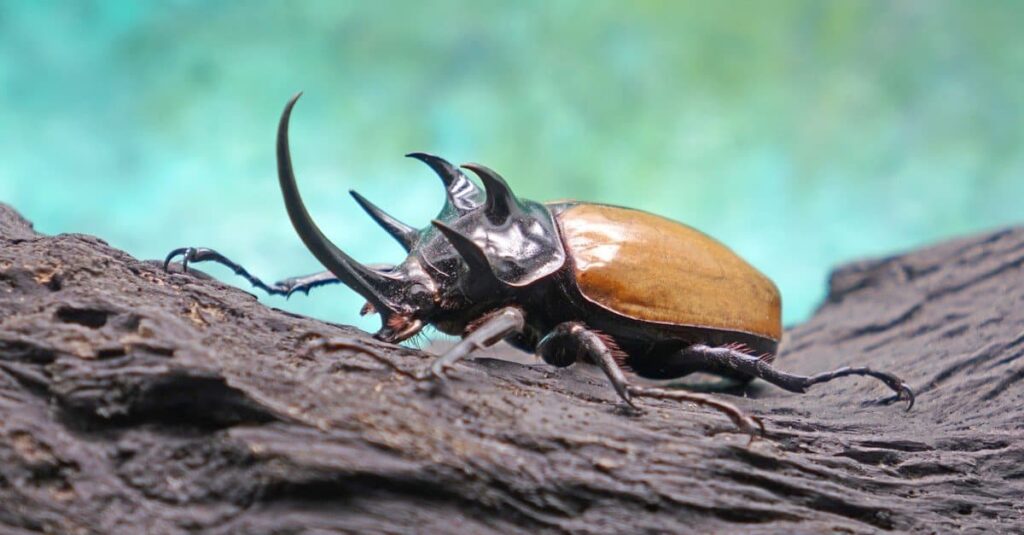
These interesting beetles are members of
Dynastinae, which is a subfamily of the scarab beetle family.
©Mark Brandon/Shutterstock.com
Rhinoceros beetles are named for their distinctive head projection that resembles rhino horns. Only males possess these horns, which are frequently used for fighting other males for breeding rights to the females. Rhinoceros beetles are members of Dynastinae, which is a subfamily of the scarab beetle family. They are some of the largest beetles in the world and can be up to 6 inches long. Rhinoceros beetles are completely harmless to humans and live on every continent except Antarctica.
28. Rhinoceros Viper
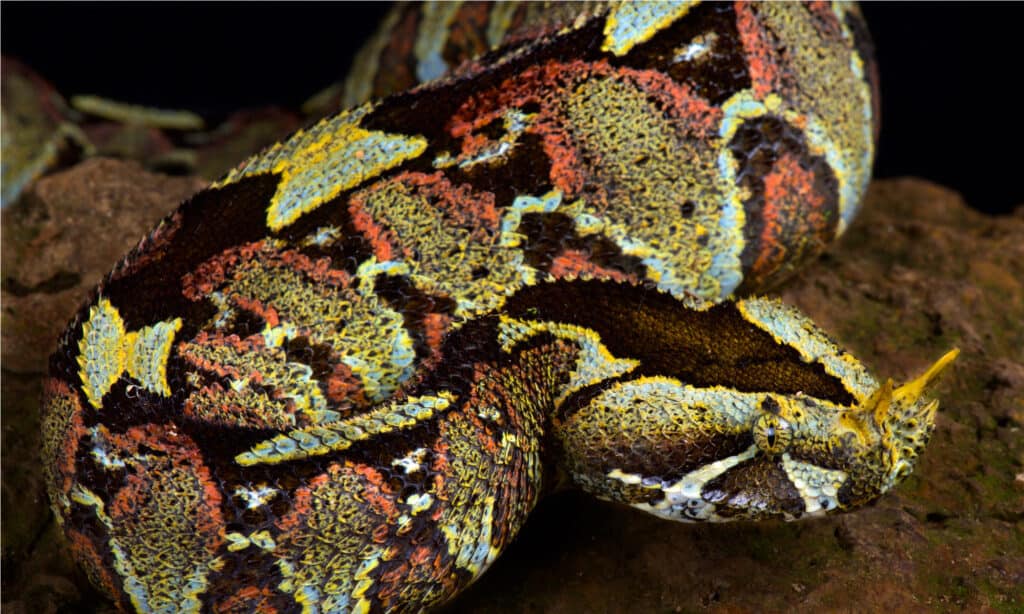
Rhinoceros vipers are 28 to 48 inches long and have a triangular-shaped head with two to three prominent nasal “horns” on the top of their snout.
©reptiles4all/Shutterstock.com
The rhinoceros viper (Bitis nasicornis) is a large snake with an unusual head. Rhinoceros vipers are 28 to 48 inches long and have a triangular-shaped head with two to three prominent nasal “horns” on the top of their snout. They have a striking appearance with a variety of black, blue, yellow, green, and red blotches. Rhinoceros vipers are native to Africa, where they primarily inhabit forests. They are venomous snakes and contain a mixture of neurotoxic and hemotoxic venom. However, little is known about their venom yield or toxicity.
29. Saltwater Crocodile
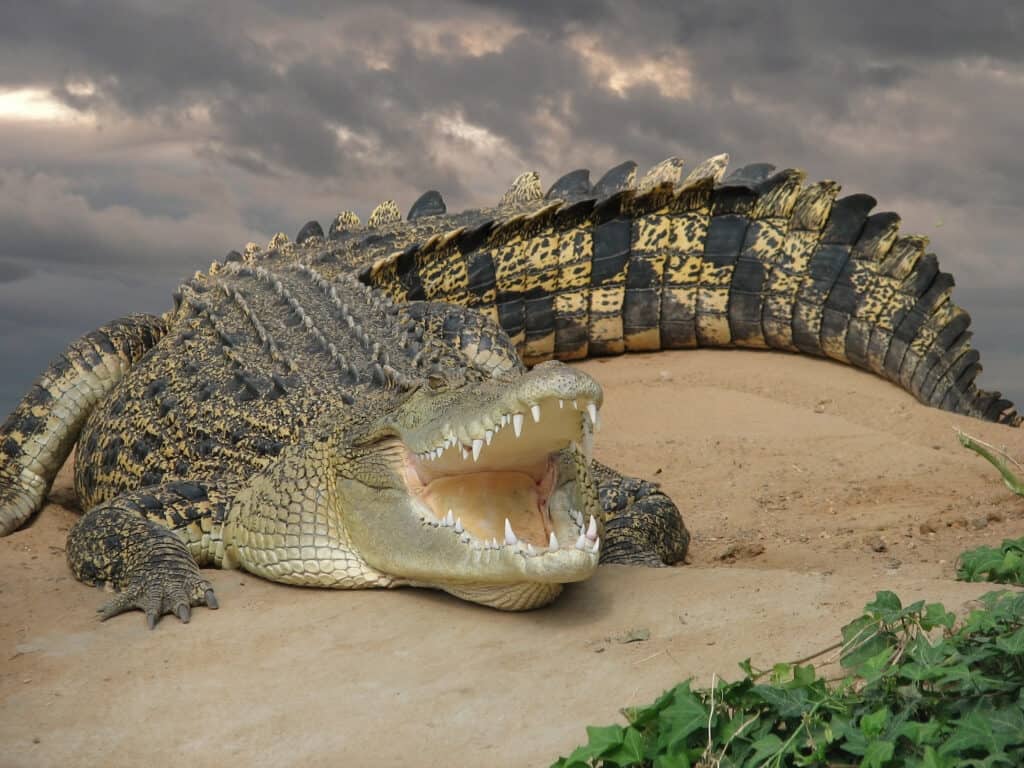
Saltwater crocodiles have 66 teeth and a massive bite force of 3,700 pounds per square inch.
©Susan Flashman/Shutterstock.com
Next, we have the largest living reptile in the world — the saltwater crocodile. Also known as “salties”, these powerful animals can reach 23 feet long and weigh more than 2,200 pounds. Although its head itself doesn’t look particularly large, its gaping mouth more than makes up for it. Saltwater crocodiles have 66 teeth and a massive bite force of 3,700 pounds per square inch. They have a widely varied diet and prey on whatever animals they can catch, both large and small. Larger mammals are typically drowned before the “death roll” is performed to break them into smaller pieces.
30. Shrew
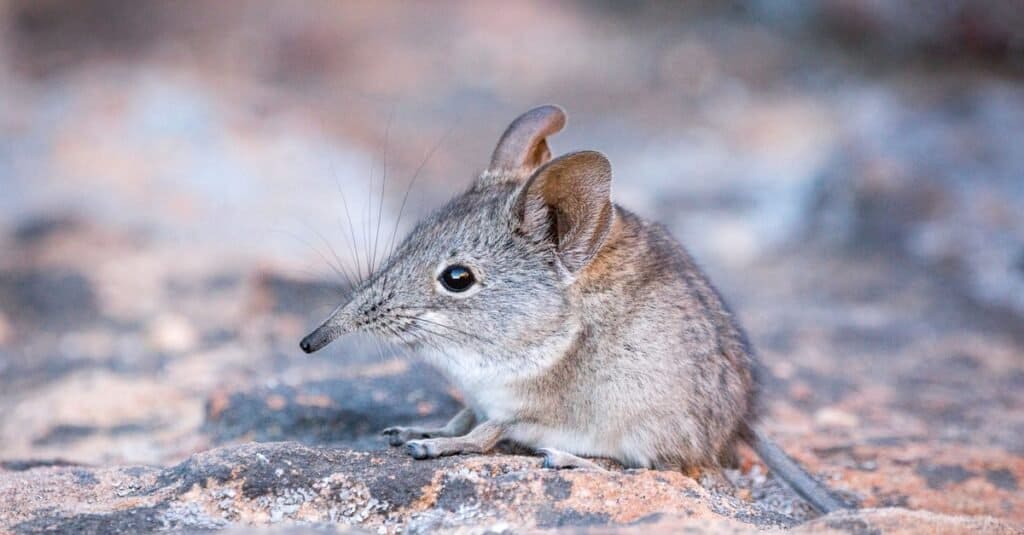
Despite their similar appearance to mice, shrews are not rodents and are more closely related to moles and hedgehogs.
©Nadine Klose/Shutterstock.com
Shrews are small mammals in the Soricidae family group, and the largest species is only 6 inches long. However, they have a large head compared to the size of their body, as well as a long, pointed snout. Incredibly, the common shrew can shrink its entire head by up to 20% in winter to help it survive in harsh environments, but then regrow it in the spring! Despite their similar appearance to mice, shrews are not rodents and are more closely related to moles and hedgehogs.
31. Tarsier

Despite their small size, they have large, round heads with huge, bulging eyes!
©iStock.com/Rachel Palmer-Goncalves
Perhaps the most unusual-looking animal on the list is the tarsier. Tarsiers are small primates in the family Tarsiidae and inhabit the forests of Southeast Asia. They are only 3.5 to 6 inches long with a tail approximately twice as long as their body. However, despite their small size, they have large, round heads with huge, bulging eyes. Relative to their body size, tarsiers have the largest eyes of any mammal in the world! In fact, each eye is larger than their brain!
32. Whale Shark
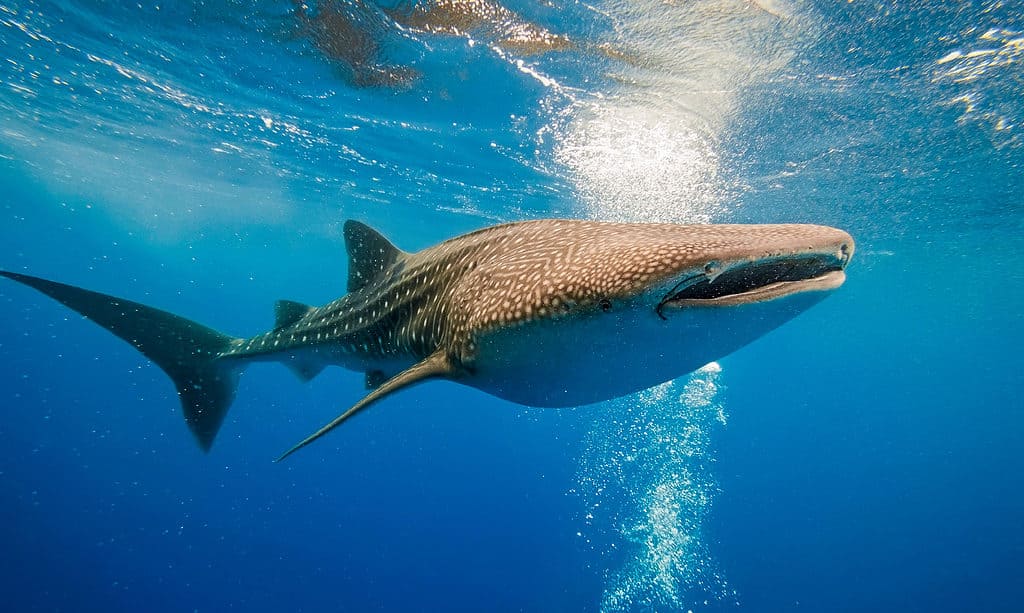
They are filter feeders and have 300 small teeth and up to 20 filter pads which they use to filter plankton and small fish through their mouth.
©Krzysztof Odziomek/Shutterstock.com
No list of animals with big heads would be complete without the whale shark, which is the largest living species of fish. Whale sharks can reach 59 feet long and have a broad, flattened head. They have a wide mouth which can be as wide as 5 feet across. They are filter feeders and have around 300 small teeth and up to 20 filter pads which they use to filter plankton and small fish through their mouth. Despite their massive size, whale sharks are completely harmless and pose no threat to humans. They inhabit tropical and warm temperate seas around the world, but they are considered an endangered species.
33. Wildebeest
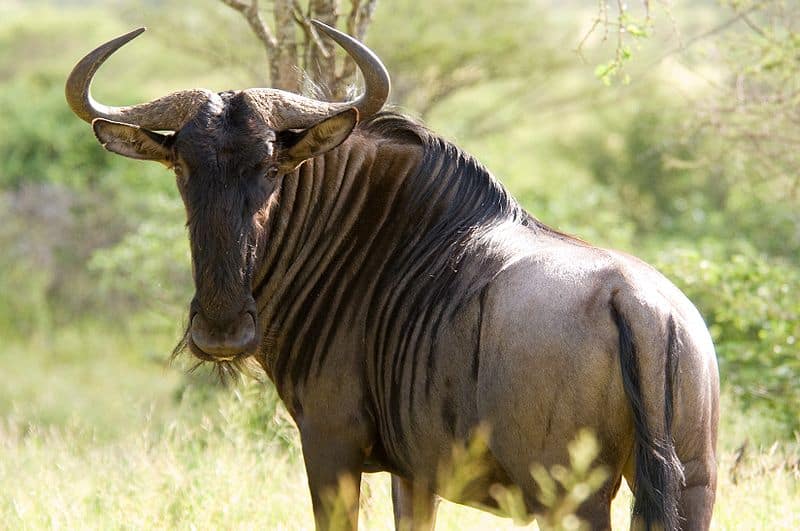
These animals are distinguished by their heavy forequarters and a long, rectangular-shaped head with a broad muzzle.
©Chris EasonCamera location24° 45′ 57.79″ S, 31° 53′ 31.74″ E View this and other nearby images on: OpenStreetMap-24.766054; 31.892150, CC BY 2.0, via Wikimedia Commons – License
Also known as gnu, wildebeest are members of the genus Connochaetes, of which there are two species — black wildebeest and blue wildebeest. Wildebeest are large herbivores that are native to Africa. They are distinguished by their heavy forequarters and a long, rectangular-shaped head with a broad muzzle. They also have a shaggy mane and beard and a set of sharp, curved horns. Blue wildebeest are larger than black wildebeest and males stand around 59 inches high at the shoulder.
The photo featured at the top of this post is © Tim Malek/Shutterstock.com
Thank you for reading! Have some feedback for us? Contact the AZ Animals editorial team.






